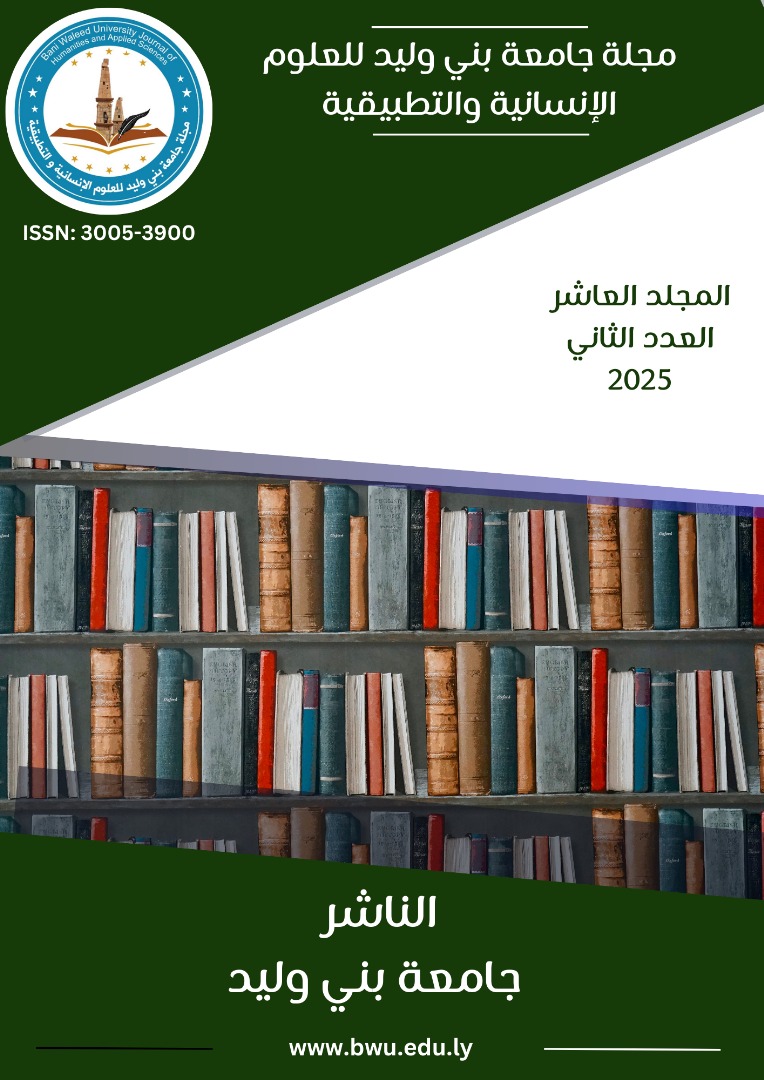An ecological study on the Peganum harmala L. plant on both sides of the road extending between the areas of Nawaqiya and Soloq, southwest of Benghazi city
DOI:
https://doi.org/10.58916/jhas.v10i2.728Keywords:
Peganum harmala, twin Span, soil factors, vegetation, LibyaAbstract
Peganum harmala is a perennial herbaceous, widely distributed in Libya, the aim of this study was to identify the community and population structures of the p. harmala southwest of Benghazi City and evaluate of ecological factors controlling the differences in plant composition of P. harmala. The classification of vegetation using the two-way indicator species analysis (TWINSPAN) resulted in the four vegetation groups(A-B) named with dominate species: group (A) Zygophyllum album - Peganum harmal., group (B) Eruca sativa, group (C) Brassica tournefortii - Inula crithmoides and group (D) Alhagi graecorum and Emex spinosus. Results of ordination indicate that performance is P. harmala L. is correlated along gradient of high E.C .and magnesium. Salinity and magnesium were the most important factors that correlated strongly with the distribution of Peganum harmal, in the study area, while the other factors as soil textures, PH, CaCO3, O.M, Cl, Na+, K+, Ca+2, N and P were have weak correlation.
Downloads
References
. Arabic Bibliography
Abu Hadra, Muhammad Nouri; Zainab Muhammad Harakat (5201). A taxonomic study of the components of the vegetation cover and observations on the environmental impact of Wadi Ghaddu in the Jfara Plain region of Libya, Al-Ustadh Journal.
Bahri, Nawara Muhammad (2017). Identification, inventory, and determination of plant species in the Wadi Kaam region, Journal of Marine Sciences and Technical Sciences, Volume (5), Issue (1).
Tawati, Attia Khalil; Abdullah Abu Qamiza; Amna Al-Ratiel (2023). The inhibitory effect of harmala plant extract on some pathogenic bacteria. The First Scientific Conference for Undergraduate and Scientific Students, Al-Asmariya Islamic University, Zliten. Saleh, Munsif Muhammad (2014). Geographical classification of soil in the Benghazi Plain. The Libyan International Journal, Issue 1, College of Education, Al-Marj, Libya.
Abd Rabbo, Hanan Saleh; Hanan Abdul Karim Khalifa (2025). A study of the effectiveness of some plant extracts against Pectobacterium cartovorium on onions. The International Journal of Science and Technology, Volume 1, Issue 36.
Al-Atr, Abdul Rahman bin Abdullah (2008). Ecological and taxonomic studies of some sand dune plants in the Kingdom of Saudi Arabia. Master's thesis, Department of Botany and Microbiology, College of Science, King Saud University, Riyadh.
Sale', Ibtisam; Maryam Al-Rubaieen; Mounir Ghafoul (2021). A field study of the best-selling medicinal and aromatic plants in the state of Djelfa. Master's thesis, College of Natural and Life Sciences, Ziane Achour University, Djelfa, Algeria.
Al-Fituri Ali; Munsif Muhammad; Mahmoud Al-Mabrouk (2022). Surface features in the Benghazi Plain: an applied geomorphological study. Journal Faculty of Arts, University of Benghazi, Libya, Issue (45).
Qanita, Bahiya bint Ibrahim bin Saeed (2011). Ecophysiological and phytochemical changes in some wild plants in the Kingdom of Saudi Arabia. Master's thesis, Department of Botany and Microbiology, College of Science, King Saud University, Riyadh.
Al-Ghanim, Suleiman bin Mohammed bin Sulaiman (2008). Environmental and plant diversity of Rawdat Salasel in Al-Qassim, Kingdom of Saudi Arabia. Master's thesis, Department of Botany and Microbiology, College of Science, King Saud University, Riyadh.
Benina Meteorological Station (1973-2000). Average of different climatic factors. Benina Meteorological Station, Libya.
List of foreign references.
Abbott, L. B., Lepak, D. and David, L. D. (2007). Vegetative and Reproductive Phenology of
African Rue (Peganum harmala) in the Northern Chihuahua Desert. The South estern
Naturalist, 52(2): 209– 218.
Aslam, N., Wani, A. A., Nawchoo, I. A., & Bhat, M. A. (2014). Distribution and medicinal
importance of Peganum harmala. A review. Int J Adv Res, 2(2), 751-755.
Alatar, A., El-Sheikh, M. A., & Thomas, J. (2012). RETRACTED: Vegetation analysis of
Wadi Al-Jufair, a hyper-arid region in Najd, Saudi Arabia.
Ali, S. I., Jafri, S.M.H., & El-Gadi, A. (1976-1988). Flora of Libya. Vols. 1-144. Botany
Department, El-Faateh University, Tripoli.
El-Gali, Z. I. (2022). Efficacy of Aqueous Extracts of some Libyan Medicinal Plants Against
Sclerotinia sclerotiorum in Vitro.
El-Monayeri, M. O.; Khafagi, O. A; Ammar, M.Y and Al-Tantaw, H. E. (1986) Adaptive
responses of some xerophytes of gravel desert ecosystem in Egypt. Desert Inst. Bull.
A.R.V.,Vol.36,No.2,pp.505-532.
Abd El-Ghani M.M. (1998). Environmental correlates of species distribution in arid desert
ecosystems of eastern Egypt. J. Arid Environ. 38, 297-313.
El-Ghareeb R. and Abdel Razik M. (1984). A study on the phytosociology of the Wadis
southern Sinai. Bull. Fac. Sci. Alex. Univ. 24(4): 213- 234.
Hill M.O. (1979). TWINSPAN-A FORTRAN Program for Arranging Multivariate Data in an
Ordered Two Way Table by Classification of Individual and Attributes Ecology and
Systematics. Cornell University, Ithaca, New York, pp: 90.
Jenkins, D., Connors, J. J., and Greenberg, A. E. (1981). Standard methods for the examination
of water and waste water. 15th ed. Washington, D.C.: American Public Health Association.
Khidr, A., El-Katony, T. M., & Soliman, N. G. (2015). Ecological assessment and fitness
variation of Elymus farctus (Viv.) Runemark populations in the Mediterranean coast of
Egypt. Scientific Journal for Damietta Faculty of Science, 5(2), 1-7
Kumar, S. (1996). Trends in structural compositional attributes of duneinterdune vegetation
and their edaphic relations in the Indian desert. Vegetation, 124, 73-93.
Li, S., Yan, N., Tanveer, M., Zhao, Z., Jiang, L., & Wang, H. (2023). Seed germination ecology
of the medicinal plant Peganum harmala (Zygophyllaceae). Plants, 12(14), 2660.
Migahid, M.M., Kamal, S. A. and Sadek, L. A. (1996) Eco physiological adaptation of some
species in the Mediterranean Desert of Egypt. J. Arid Environ.34:11-21.
Noss, R.F. (1990). Indicators for Monitoring Biodiversity: A Hierarchical Approach
Conservation Biology, 4, 355-364.
Omar, OI. Naser G El-Mghrbi, Rebeh O Rahil, Mohamed A Alaib, Abdul Hamid K Alzerbi
(2021) Floristic Composition and Plant Diversity of Western Part of Wadi El- Enaghar,
Libya .Species, 2021, 22(70), 204-217.
Obata T, Fernie AR. (2012). The use of metabolomics to dissect plant responses to abiotic
stresses. Cell. Mol. Life Sci. 69, 3225–3243. (doi:10.1007/s00018-012-1091-5)
Richards L.A.(1954). Diagnosis and Improvement of Saline Alkali Soils, Agriculture, 160,
Handbook 60. US Department of Agriculture, Washington DC.
Tahraoui, A., El-Hilaly, J., Israili, Z. H., Lyoussi, B. (2007). Ethno pharmacological survey of
plants used in the traditional treatment of hypertension and diabetes in south-eastern
Morocco (Errachidia province) J Ethnopharmacol.110:105–17.
Ter Braak C.J.F. (1987). The vegetation-environment relationships by Canonical
correspondence analysis. Vegtatio 69: 69-77.
Walkley A.; Black I.A. (1934). An examination of Degtjareff method for determining soil
organic matter, and proposed modification of the chromic acid titration method. Soil
Science 37:29-38.
Selkhozpromexport (1980). “Soil Studies in the Eastern zone of Libya ʺ. Secretariat for
Agricultural Reclamation and Land Development, Tripoli.
Wang, X. Li. Y . Z., Meng, H. Dong, H. Guo, Y. & Tong, S. (2015). Distribution pattern of
plant community in new-born coastal wetland in the Yellow River Delta. Scientia
Geographic Sinica, 35(8), 1021 – 1026








